|
SEPTEMBER 2019
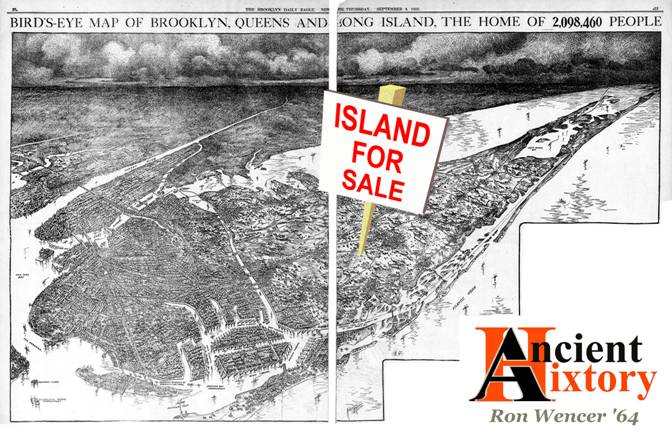
Arthur H. Heiser,
Bird's-Eye Map of Long Island (annotated by author)
Brooklyn Daily Eagle, September 8, 1910
Hicksville
Becomes a Suburb (Part II)
On
Tunnel Day (the day in 1910 on which the LIRR first carried passengers
beneath the East River), the Brooklyn Daily Eagle printed a two-page
detailed aerial drawing of
Long Island
. The implication was clear:
For New Yorkers who had been longing for homes outside the City, the
whole of the
Island
now was within reach. There
also was a corollary: For developers - land speculators and builders,
who for a number of years had prepared for this day by acquiring
inexpensive farms and woodland - the time to harvest the profits of
their investments was approaching. Caught
up in the frenzy of Tunnel Day, many city-dwellers began to think about
riding trains east, in search of suburban homes or weekend beach
properties.
Other pages of the same edition featured
large advertisements that tried to attract readers to specific towns.
The whole Tunnel Day issue was quite educational, and also
well-sprinkled with hype. For
example, readers learned from it that Patchogue was The
Metropolis of the South Shore, and even that Northport was The
Naples
of the
North
Shore
.
|

|
|
Brooklyn
Daily Eagle, September 8,
1910
|
|
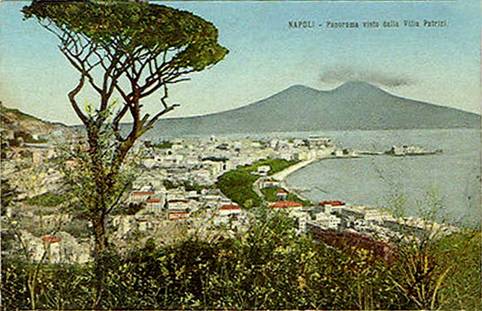
|
|
Apparently,
someone found it difficult to believe this was not
Long Island
.
1910 postcard of
Naples
at picclick.com
|
It is easy to be cynical, but
there were good reasons for city folk to relocate to Long Island, and
many communities on the
Island
welcomed development and a chance to grow.
Today, with more than a century of hindsight available to us, we
have more perspective through which to trace how the transition to
suburbia began in the years before the
U.S.
went to war in 1917.
***
Jumping the Gun
No one ever had been able to ride a
train under the
East River
, and then one day anybody could - the change happened overnight.
Yet, like the tunnels themselves, the public's interest had
been growing steadily for years, years during which some people decided
not to wait, but to move east to
Nassau
County
. The promise of the tunnels
had lured "leading edge" commuters to the
Island
, people who were willing to tolerate commuting the old way for a few
years. These early birds
reasoned that their new suburban homes would have cost much more had
they waited to buy them until the tunnels opened.
LIRR
statistics illustrate how the ranks of these new commuters grew.
In 1901, the railroad had carried passengers on 14.5 million
trips; in 1909, there were 27.5 million trips.
By the time direct service to
Manhattan
began, the number of commuter trips likely was twice what it had been
back in 1901. For August
1910 (the last pre-tunnel month), the railroad sold 17,354 monthly
commutation tickets. For
stations in the vicinity of
Hicksville
, monthly commutation ticket sales for that August were as follows:
|
Westbury
|
32
|
|
Syosset
|
36
|
|
Central
Park (now
Bethpage
)
|
50
|
|
Farmingdale
|
58
|
|
Mineola
|
67
|
|
Massapequa
|
79
|
|
Hicksville
|
85
|
***
One Lot at a Time, or A Whole
Lot
at a Time?
To those of us who grew up in
Hicksville
after WW II, seeing a few standard models of houses repeat across large
subdivisions seems normal. In
early 1900s
Nassau
County
, however, it was something new. Traditionally,
most rural homes had been built one at a time, usually for the people
who expected to live in them. Sometimes,
when there was a need to house a number of new people in a village,
several homes might be built at more or less the same time.
There was a limit as to how much could be done at once, for
building many houses at the same time in one locale took more materials
and skilled labor than most small country builders could muster.
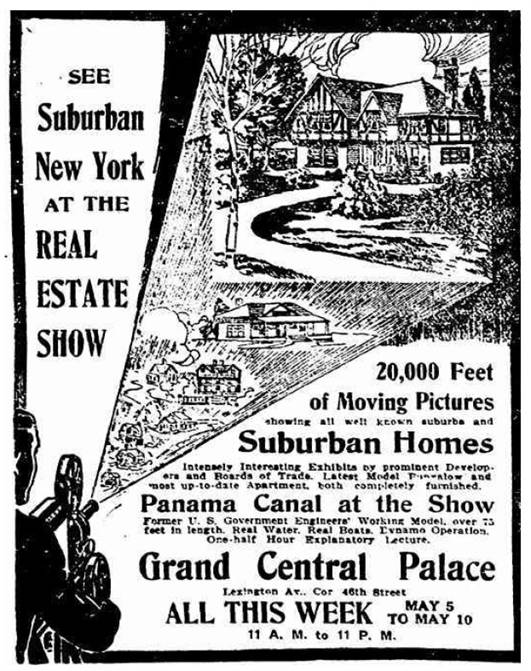
New York
Sun, May 6, 1913
Now, like holes forming in a dam, the
tunnels were almost ready to release pent-up pressure.
A flood of
New York City
families was going to need thousands of new homes, all at once.
To meet that need, builders would resort to building houses in a
few standard varieties, designed to anticipate the tastes of
hypothetical average buyers. Small,
hands-on individual builders began to fade, as construction companies
built subdivisions. Every
month, more farms and woodlands were turning into open land with new
streets. There was not much
town planning; houses were erected wherever land convenient to
transportation could be purchased. Chunk
by chunk, the character of
Long Island
was beginning to change.
Long before the railroad finally rolled
trains into
Manhattan
, speculators had bought large tracts of land.
As the tunnel construction progressed, "land companies"
offered parcels of land to builders, who would construct houses and put
them on the market as soon as they could.
Advertisements like the one below had appeared well in advance of
Tunnel Day, and they would keep appearing, as long as there was land
to be sold.
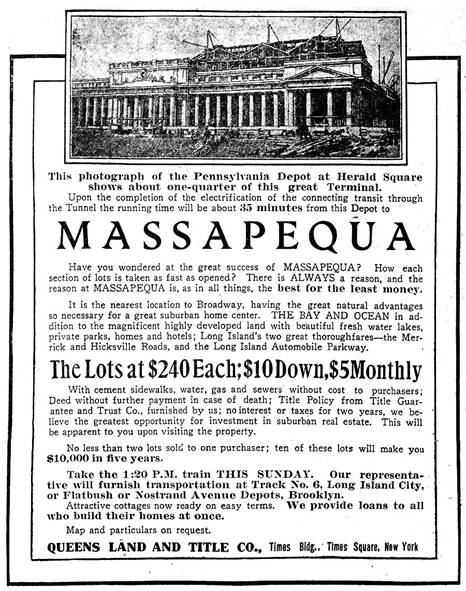
Note that one advantage of
Massapequa was
Hicksville Road
,
one of "
Long Island
's two great thoroughfares."
Brooklyn
Daily Eagle, April 17, 1909
*
The Long Island Railroad placed a full-page ad in local newspapers,
promoting the idea that
Long Island
(thanks to its beauty and variety) was a great place to visit, and also
a great place to live.
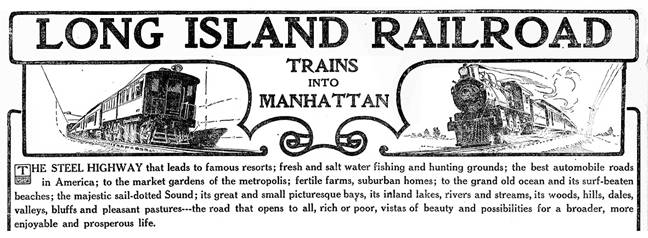
Brooklyn
Daily Eagle, September 8, 1910
After the introductory words above,
the advertisement took the reader from Pennsylvania
Station, "the handsomest and largest [railroad station] in the
world," through the "marvelous" tunnels, to places where everyone
could find everything they might ever want.
No exaggeration there, right?
There were fertile soils in which to plant, beaches at which to
bathe, fishing reserves, and golf courses galore.
The local roads (almost all of which were unpaved, incidentally)
were "superb." Along the
way, the reader was treated to pictures like One
of Long Island's Charming Nooks, A
Bit of
Long Island
Sea
Coast
, or this one:
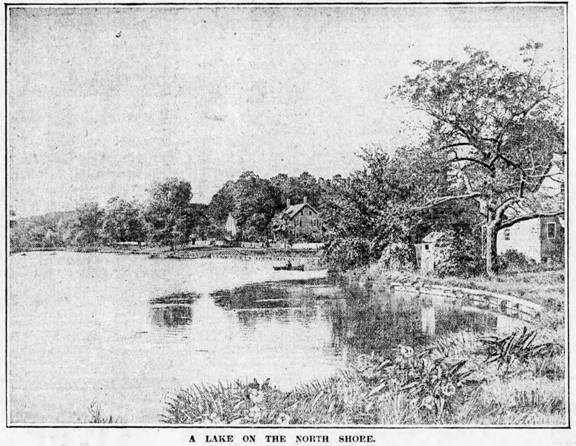
The photographs were well chosen to
entice vacationers, but none of them hinted at all the houses that would
have to be built nearby in order to house new middle-class residents.
Obviously, there was a flaw in the idea of encouraging commuters
by the thousand to live in unspoiled rural surroundings.
The more people who bought into the idea, the less likely it was
that idyllic spots on the
Island
, the magnets that drew people eastward, could survive as they were.
Soon there would be coal-fired generating stations, power lines,
new roads, sidewalks, gas stations, clumps of housing, and at least
twice as many people as before.
Looking back at that day's edition of
the Eagle, one may feel that
there was more na´vetÚ than dishonesty at work, but either way, it
overlooked most of the negative implications of the suburban life that
it was promoting. At times,
there even was some levity:

Yes, this was the lead-in to a
Long Island
real estate advertisement.
***
Some Places Are More Equal Than
Others
Not every town on the
Island
could inspire glowing advertising copy.
The earlier ad for lots in Massapequa mentioned a bay, the ocean,
some beautiful fresh-water lakes, and (glossing over the fact that all
towns funneled into the same East River tubes) even the "great
terminal" in
Manhattan
through which new commuters from the town were to travel.
In contrast, the modest ad below took a pragmatic stance.

Brooklyn
Daily Eagle, April 16, 1912
There were good reasons for this.
Most New Yorkers already had some idea of
Hicksville
. Its hotels, especially the
Grand Central, long had
attracted New Yorkers who wished to hunt or go for sleigh rides.
In recent years, it had become the end point of a trolley line
that penetrated into
Queens
. The first Vanderbilt Cup
race had gone through
Hicksville
, as did the 1909 and 1910 races. It
was a "real place" - Mr. Heinz, who could put factories wherever
he chose, had built a big plant there.
Did anyone reading this advertisement need to be told much more
about
Hicksville
?
The other side of the coin, of course,
was that for all its advantages, the village had no bays or lakes.
It was about as far from the seashore as one could get on
Long Island
. It would have been
impossible to argue that
Hicksville
was remarkably picturesque. But
did that matter very much? The
advertisement told prospective commuters things they needed to know.
The village had trolley service, schools, churches, and good
shopping. It was only eight
miles from
New York City
(well, from the
Queens
County
line). Houses built on lots
near the station allowed commuters to walk to their trains, even in bad
weather. Lakes and seashores
would have been appealing, but commuters only cared about such things on
weekends; during the work week,
Hicksville
gave commuters what they wanted.
A
Personal Reminiscence:
I
still recall very clearly my first visit to
Hicksville
, when I was seven years old. As
the real estate agent showed a house to my parents, he told them that
from it my sister would be able to walk a few blocks to what would
become the old High School, that the new High School would be even
closer, and that my elementary school would be almost as close.
My father observed that he would be able to walk to the railroad
station. I realized then
that I was looking at my new home.
***
Hicksville
,
the 1911 Version
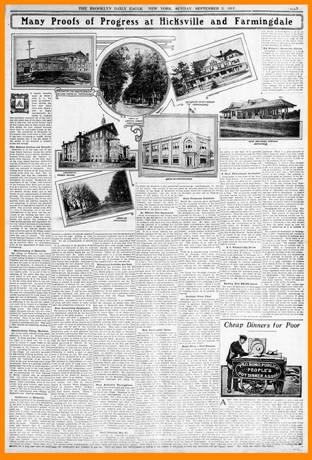
Brooklyn
Daily Eagle,
September 3, 1911
As noted here last month, the
newspapers of the day offered profiles of various communities on
Long Island
. The Eagle
ran a regular series of such profiles, and about a year after Tunnel
Day, it turned its eye to
Hicksville
and Farmingdale. The
contents of the profile which relate to
Hicksville
are discussed in this section; if you would like to read the entire
profile, you can do so by clicking on this URL: https://bklyn.newspapers.com/image/53899087/
The profile tried to demonstrate that
both villages were good places for the families of commuters.
Indeed, the story begins by suggesting that
Hicksville
is so desirable that it already is in the midst of a severe housing
shortage. Curiously,
although the text of the article is balanced equally between the two
villages, the photographs are not: Farmingdale gets four of the six
photographs - as with the earlier advertisement, perhaps a symptom of
the core of
Hicksville
not being very elegant.
Which parts of
Hicksville
are used to make a good impression on the reader?
First is the new railroad station (and its lovely landscaping!),
which had cost $82,000 to build. Incidentally,
the Eagle's reporter erroneously states that the depot is at Broadway
(this was actually the location of its predecessor), whereas it was just
west of
Jerusalem Avenue
. Very little else is said
about the building itself, but there is a lengthy discussion of the LIRR's history, and also mention of a competition among all the
line's railroad stations, to win prizes for cleanliness and
landscaping.
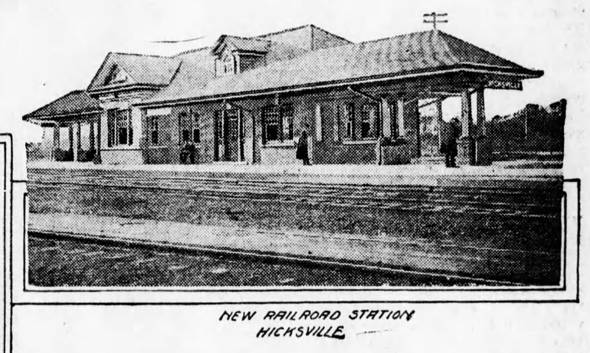
The only other
Hicksville
photograph depicts an unlabeled stretch of Mary (soon to be renamed Marie)
Street, its broad unpaved roadway flanked by trees and large houses.
I imagine that this was the most picturesque view the
photographer could find in the time allotted to shoot pictures of two
villages No sarcasm is
intended; when I was young, I loved walking around the old streets -
which by then had been paved; I'm not that
old - under their big trees, especially in the autumn.
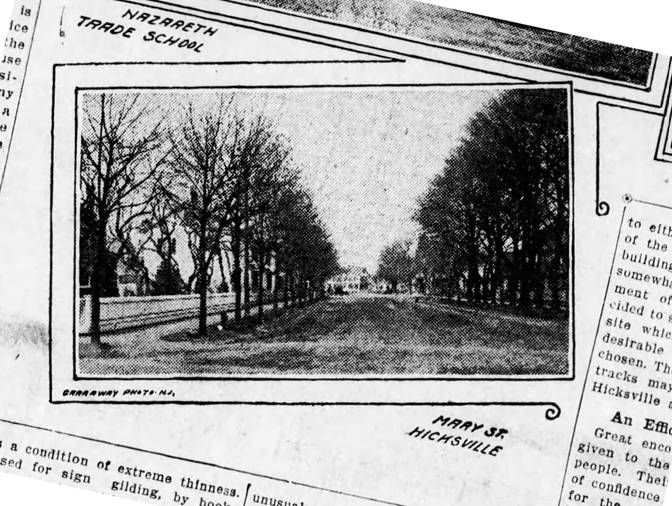
*
What is said about the village as a
whole?
Determining the population accurately
would be difficult, due to the ongoing influx of new residents.
The profile estimates it at 3,000, which is inaccurate.
Even at the end of 1917, the village had not yet become home to
that many people. It states
that the citizens of the village have consistently voted to pay for
civic improvements, such as cement sidewalks.
The village is home to a number of industries, including
gold-beating, dressmaking, brushmaking, making food products, and - if
things go well - airplane manufacturing.
Hicksville
's "central role" with respect to the area's farms is
acknowledged. Its retail
stores are highly recommended, its Fire Department is excellent, its
water is good, and its financial institutions are to be praised.
Much attention is devoted to
Hicksville
's educational institutions. In
the school buildings on
Nicholai Street
(which have benefited from a recent $30,000 expansion), teachers
instruct students in grades ranging up through the second year of high
school. The total number of
students (450) includes some high school students from other
communities, whose own schools do not offer education at that level.
At the
German
Lutheran
Church
, there are classes in German language and literature.
St. John's Protectory provides both academic and work-oriented
studies for hundreds of resident boys, orphans "from Brooklyn" (an
indication that the Roman Catholic Diocese of Brooklyn had confidence in
the village, but otherwise, the Protectory's good work was unlikely to
attract new residents to Hicksville).
***
Conclusion
Between 1910 and 1917,
Hicksville
's population increased by 19%, from fewer than 2,400 to about 2,850.
One can assume that a good part of that increase was due to an
influx of commuters. Perhaps
75 new families had settled in
Hicksville
, many of them in new houses. The
figures suggest that the recent expansion of the school would not get
the job done for long, as within a few years the student population
would increase substantially.
The infrastructure of the village was already expanding (e.g., new gas
lines were being laid), and total farm acreage was shrinking a little;
Hicksville
was on the brink of a big change. But
the country soon would be at war, and such matters would be put on hold
for a few years.
*
I find one part of the profile
intriguing:
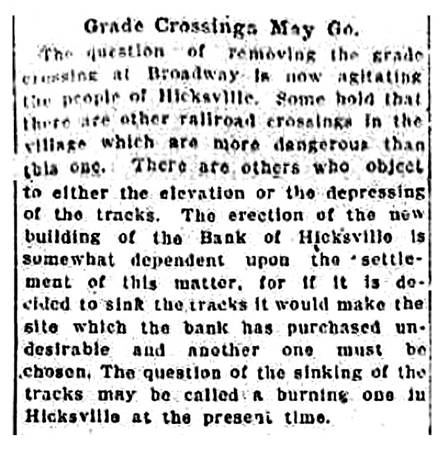
As we saw last month,
Hicksville
got its start when the railroad tracks temporarily ended at a junction
of three well-used roads. Because
everything - roads, rails, and people - came together there, a
thriving village developed. Railroad
crossings had always been at the heart of
Hicksville
.
By 1900, however, there were more wagons,
a growing number of automobiles, more and faster trains, and more tracks
to cross. Because of all the
grade crossings, navigating the village now was more dangerous than it
was when
Hicksville
was a sleepy little place. Everyone
knew that, and yet for decades no one - not the governing powers of
the village, of the Town of
Oyster Bay
, or of
Nassau
County
- would do anything about it. And
in the end, no one would find a way to preserve the character of old
"downtown" tree-lined
Hicksville
when the problem finally was addressed.
***
Post
Script: Something Completely Different
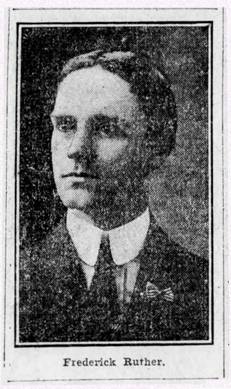
Brooklyn
Daily Eagle, March 7, 1909
In 1909, young Hicksvillian Frederick
Ruther was inspired by the promise of the tunnels between
Manhattan
and the lands across its rivers. He
understood that
Nassau
would become a place of suburbs, but he had a novel - some would say a
frightening - idea of what instead could, and what should, happen to
Suffolk
. He devised a proposal that
showed how the Eastern part of
Long Island
could be made prosperous. It
also was a way to accomplish other things which Ruther felt were
important, such as generating work in
Suffolk
for people with technical educations, and making possible a
restructuring of freight rates, so that eastbound and westbound freight
transported by the LIRR would
finally be subject to the same tariffs.
Key to his proposal was a direct rail connection, running part
way by bridge, part way by tunnel, across the Sound between Orient Point
on Long Island and Watch Hill Point on the shoreline of
Rhode Island
.

Ruther was opposed to reserving
parts of eastern L.I. as "playgrounds for the wealthy."
For that matter, he saw little use for
Suffolk
's natural beauty, except perhaps for attracting a "better class"
of wealthier tourists, who would spend more money at resorts.
He lamented that
Long Island
's hundreds of miles of coastline were being wasted, because the
"sea coast, with all its deep harbors and bays, is of no value to the
manufacturer."
In his proposal, the Long Island Railroad was to become a connecting railroad for the
shipment of manufactured products and raw materials, a link between New
England and (via the tunnels to New York City) "All Points West."
Better access to new markets and materials would spark an
industrial boom in all of
Long Island
. Clearly not inclined to be
modest, Ruther predicted that his proposal's economic benefit upon the
Eastern United States would exceed the transformation which the
Erie Canal
had triggered a century before. He
foresaw steady and enduring growth, so that people could work where they
lived, leaving no room in the east for commuters from NYC.
As they grew, all the villages and towns would blend into one. In
Frederick Ruther's vision of a happy future, prosperity would "make
one big city of
Long Island
." Imagine that!
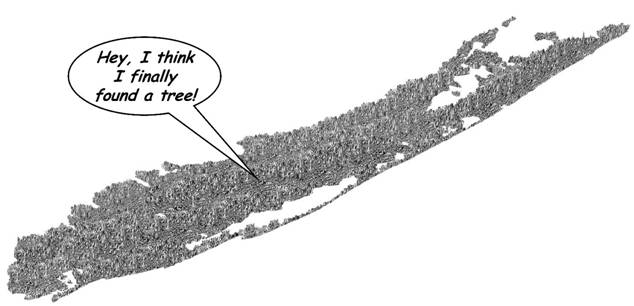
*
Of course, his proposal fell mostly
upon unreceptive - not necessarily deaf - ears, for there were many
arguments against it. To the
north, several other railroads already had effective freight links
between
New England
and the West, links which bypassed Greater New York.
If there was any merit to connecting
LIRR rail freight service to
Rhode Island
, to some degree that could be accomplished putting freight cars on
"car floats" (i.e., barges with railroad track on their decks) and
using tugboats to get them across the Sound.
For higher volumes of freight, plans were already being finalized
for the
Hellgate
Bridge
, which in a few years would serve as a direct freight rail connection
with
New England
.
In his proposal, Ruther does not discuss
the details of a through freight connection from the LIRR to western railroads. The
reader might infer that the freight trains he discusses could travel
through the new tunnels then being built for use by the Pennsylvania Railroad and the LIRR.
Not so - those tunnels were designed to withstand only the load
of passenger trains; freight trains would weigh significantly more.
Regardless, for the sake of safety, rail tunnels beneath
New York City
were restricted to trains moved by electric power.
It would be almost two decades before an electric locomotive
suitable for heavy-duty freight would be in service anywhere in the
country. Until then, batches
of freight cars - not trains - would continue to creep across
New York
Harbor
on car floats. All the
region's railroads already owned tugs, floats, and special docks for
that purpose.

New York
Central Railroad tugboat moving a
float of boxcars in the harbor
Museum of the City of
New York
https://collections.mcny.org
In addition to the apparent
impracticalities, the proposal presented a conceptual challenge, the
implications of which could be sweeping. From the beginning of European
settlement, development had been shaped by the land's being an island.
Roadways ran from the shore to inland, or from shore to shore.
As
Manhattan
grew from a handful of Dutch houses to the most populous city in the
country,
Long Island
responded to its neighbor's eminence, and the east-west routes of
transportation became dominant. Brooklyn
long was a buffer between the City and
Long Island
. As Brooklyn grew to be the
country's second-largest city, it tried to present itself as an
alternative to
New York
(in the same way that 7up used
to identify itself as The Un-Cola).
After a while, people considered the Island an adjunct to
Manhattan
, not to mainland
America
. As a whole, the
Island
was a destination, not someplace to pass through on the way to somewhere
else.
Constructing the link that Ruther
proposed would guarantee nothing to
Suffolk
County
, except for long freight trains running non-stop through it.
Was it necessarily true that new
Suffolk
industries would be a logical part of a cross-country rail service, or
would the requisite local access points just get in the way?
Let's say that local industry did
blossom. Jobs might make it
necessary for people to frequently travel back and forth between Long
Island and the factories of
Rhode Island
and
Massachusetts
. Some people from one side
would commute to the other. Others
would pack and move their homes across the Sound.
The
New Haven
and the
Long Island
might merge into a single railroad.
Eventually, the mega-city of
Long Island
would lose its "island" identity, and be just one more
"someplace" through which people happened to pass.
*
From time to time, Frederick Ruther
made other, less grandiose proposals.
One was to develop the deep natural harbor of Greenport into a
transatlantic port, which would have meant creating a smaller version of
New York's waterfront with busy docks, warehouses, fuel dumps, cranes,
etc., so that freight could be moved back and forth between ships and
the LIRR.
The town of
Greenport
seemed to be much in favor of the idea.
While waiting for the world to embrace
his foresight and reinvent itself, Ruther worked as a real estate agent,
first in
Hicksville
, and later in Center Moriches. Occasionally,
he organized tours of Eastern L.I., some of them quite lengthy, in which
he shared his extensive knowledge of the area's history and geography.
He also wrote books, with photographs which now are of great
interest to local historians.
*****
Finito!
|
















